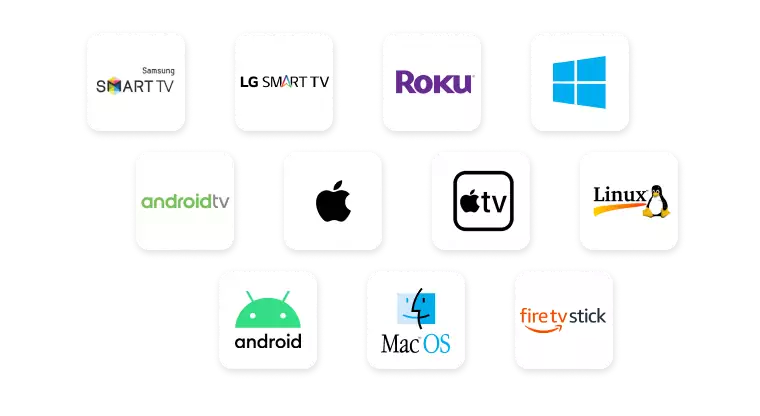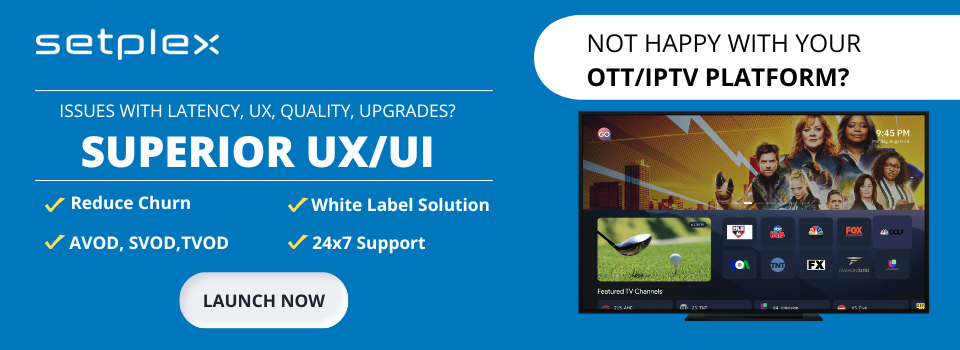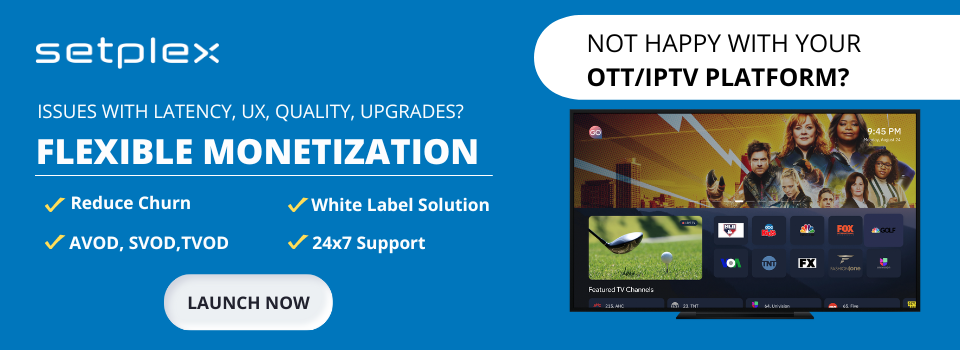In 2020, the global OTT market size was estimated at $38,77 billion. The researchers predicted that it would grow to $139 billion in 2028. According to their estimations, the OTT market CARG will be 17.7%.
What influences the growth? Internet penetration, Smart TVs, smartphones, 5G infrastructure, and original content are going to boost the market and expand its capabilities.
If you are still not sure whether to build a video streaming app or not, let’s dive deeper into the industry overview.
Table of Contents
- Video Streaming Industry Overview
- What is a Streaming App?
- Types of Streaming Applications
- How to Create a Streaming App Like Netflix in 5 Steps
- Questions & Answers
- Conclusion
Video Streaming Industry Overview
During the COVID-19 pandemic, online video streaming services like Netflix and HBO became more popular than ever. The pandemic ended, but these services are still on the rise. Such a demand occurred due to high-quality images, availability on different platforms, and advanced internet infrastructure.
Depending on the platform, the market is segmented into smartphones, laptops, tablets, Smart TVs, and others. As researchers say, there is a demand for Smart TVs with features and functions across the world, and it is increasing. The smartphone market share dominated the OTT market in 2019 and is expected to prevail due to 5G and new smartphone models. The adoption of tablets and laptops is growing as well.
The multi-platform capabilities are profitable for content creators. The more devices you can reach, the more revenue you will generate.
Inspired to create your streaming app?
What is a Streaming App?
Streaming is a method of delivery when live or recorded content is transmitted through the Internet to an end user’s device. A streaming application is software that allows viewers to access content without downloading it on a device.

Types of Streaming Applications
The format of video streaming can vary. When you decide to build a streaming app with Setplex or another online video hosting platform, you should define what type of video streaming application you want.
VOD (Movies, TV Shows, Educational videos)
VOD stands for Video-On-Demand streaming. The video content is stored on servers. Thanks to that, viewers can request a video at any time. The video will be delivered to the user’s device via the Internet.
VOD streaming makes it possible for people to watch videos without downloading them on gadgets or buying CDs and DVDs. VOD services are equipped with features that allow viewers to watch videos however they want – pause, resume and rewind. What viewers like about VOD services the most is that they can binge-watch content as long as they want.
Popular examples of VOD:
- Netflix
- Amazon Prime
- Hulu
Live Streaming (Sports, Church services)
When you are creating a live-streaming app, you should be ready for tough competition. There are Twitch, Periscope, Livestream, Clubhouse, and giant social media services with built-in live streaming functionality – Instagram Live, Facebook Live, YouTube Live, and Twitter Live. If you want to be in the same row as they are, you need to come up with unique features or concepts.
The live streaming app transmits videos in real-time, without being recorded and stored like VOD content. The viewers receive the content at the same time as it is being created.
The term also refers to multicast streaming – the content creator, or the streamer, sends information to many viewers simultaneously.
TV Live Streaming
The majority of VOD streaming services offer content that viewers cannot find on television. When consumers cut the cable or satellite television cord, they stop watching their favorite TV shows and series.
That’s the reason why huge companies like Hulu or YouTube TV added TV live broadcasting plans to their services. People can still watch their favorite shows, and they don’t need cable anymore. Viewers use an internet connection, which is much easier, cheaper, and more flexible.
Audio Streaming
The concept of audio streaming is similar to VOD streaming. Such services also offer a library of music content that people can access whenever they want.
Consumers can listen to music or podcasts without downloading them on their devices. Music streaming app development is less complicated, and audio records require less space on servers.
Examples of audio streaming apps are Spotify and Apple Music.
How to Create a Streaming App Like Netflix in 5 Steps
We have covered what a streaming app is and its types. Now, let’s talk business. Whether you are going to make a live streaming app or a VOD streaming app, you should do a couple of things as a part of your OTT business plan for a video streaming app.
Step-by-step guide for building a streaming app:
Step 1 – Identify your audience
Don’t create a streaming app without knowing your audience and its needs. Don’t guess and assume. You will likely make mistakes when forming an image of your customer. It is better to research and learn your audience’s interests and needs before diving into streaming app development.
The deeper you will understand who these people are, the better application and content you will create for them.
Step 2 – Delve into streaming app development
When starting your own streaming app, you will need to think through many things. Let’s make an example.
- Platform
When we say “platform,” we mean devices on which your viewers will access your videos. For example, Setplex clients deliver videos to smartphones, tablets, Smart TVs, or desktop computers.
- Technical stack
For streaming app development, the following technical stack is usually used:
Programming languages: Swift (iOS), Kotlin (Android), Java or Go (back-end)
API server: Node.js, Go
Media processing platform: Setrix
CDN: Akamai, Cloudflare, Streampool by Setplex
Database: MySQL, Postgres
Hosting depends on the territory you want to cover.
Before you hire anyone for the job, consider well your budget and specialists in the market.
- Content security
Whether you obtain licensed content or create your videos, you should have proper security. For example, you want to share programs from the Discovery Channel. The channel owner will ask about your safety protection.
Video piracy thrives. Some people don’t want to pay for access. They steal content and share it for free. In this case, you will lose money and have to pay the penalty to the primary content owner.
One of the security solutions widespread among video streaming app developers like Setplex is DRM (Digital Rights Management). It will protect your copyrighted materials from unauthorized access, distribution, and modification.
The security measures ensure that the content will be shared with your audience exclusively and prevent malicious actors from stealing it.
CDN can perform many functions for your video streaming business. The primary goal of CDNs is to deliver content over long distances. But there is more.
Suppose you broadcast an important sports event, and hundreds of thousands of fans come to watch a live stream. It is a huge server load. If you want your server to be able to handle such traffic, you will need a CDN.
Content Delivery Network makes a copy of a video and distributes it on other servers. As a result, the content is transmitted not from the original server, but from the one that is closer to the viewer. And consumers watch the stream without interruptions.
CDN speeds up content delivery and enhances security from DDoS attacks. If your competitor wants to harm your business, they can overwhelm your server with bots. The server goes down, and you lose viewers and revenue. CDN will spread out this traffic and help you continue operating. Don’t forget to consider CDN costs.
Step 3 – Find experts
You can hire an in-house development team or outsource your project. Consider your budget first when deciding on what option to choose.
Having a team of employees will come at a cost as you will probably need software engineers, marketing specialists, UI/UX experts, and graphic designers. It is a long and tedious process. Moreover, if you don’t have technical knowledge, you will need a consultant to help you estimate the specialists’ skills.
You have an alternative that simplifies the process of streaming app development. You can acquire a Setplex white-label solution with all the components for a video streaming business. It saves a great deal of time and money.

Step 4 – Create a user-friendly UI/UX design
Appearance matters. Your platform design contributes to the user experience. A good user experience keeps customers returning. Make sure your app is appealing and user-friendly.
You can do a competitive analysis and explore the features they have, as well as the structure of the application. Think about how you would enhance their streaming apps – this way you can generate ideas for your app.
Step 5 – Build, test, and release your streaming app with Setplex
After you’ve laid the groundwork, you can launch a streaming app. Setplex will help you in case you obtain its ready-made solution.
If you have decided to take a complicated route and create your own streaming app, we recommend you make an MVP version (light version) first and let users test it. You will receive feedback that can help you understand weaknesses and strengths and make adjustments.
If you want an outstanding solution with less effort, you can use a white-label solution like Setplex. You will save plenty of money and time. With Setplex, you will be able to start sharing video content and monetizing it right away.
As soon as you’ve released your app, use OTT analytics to understand what works right or wrong on the platform. Many ideas on how to improve your service will come up.
Questions & Answers
Who needs a video streaming app?
Every industry can generate revenue by having a streaming app and publishing video content:
- Governments
- Cable or satellite companies
- ISPs/MSOs
- Content creators:
- Churches
- Sports clubs
- Educational institutions
- Hotels and Entertainment
- Yoga and meditation specialists
- Kids content producers, and any other community influencers
How do I monetize a streaming app?
There are several monetization strategies for a streaming app:
- Advertisements – you allow third parties to advertise on your platform and charge money for that.
- A paid app – users need to purchase an application in the store.
- Paid content – you can sell subscriptions to your content or charge a fee for each video you publish.

Contact Setplex
Start Building Your Apps Today.
Take your IPTV/OTT platform to the next level with the support of the Setplex team. You’re ready for your platform to take off. Have an expert call you today to see how quickly your apps can launch and your service grow. Contact Setplex.




1 Comment
Claire · December 26, 2022 at 10:54 am
I have recently started a business, the information you offer on IPTV/OTT platforms has helped me greatly. Thanks for all of your time & work.